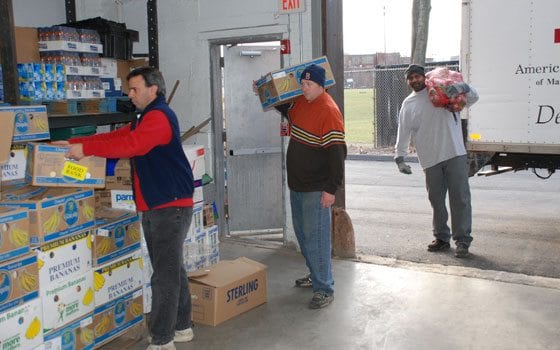

Author: Tony IrvingAt the American Red Cross’ food pantry on Massachusetts Avenue in Roxbury, associate director of food and nutrition programs David Andre (left), volunteer Philip Brener (center) and food and nutrition staff member Derek Clarke load boxes and bags of food into a truck that will deliver supplies to other local pantries. With funding scarce and demand rising, this winter is shaping up to be a dicey one for Boston-area service-oriented nonprofits.
Food pantries and other service-oriented nonprofits in Boston and across the state are getting ready for what could be a perfect storm of increased demand, lower supply and a scarcity of cash as they try to stem rising homelessness and hunger rates this holiday season.
Record layoffs, tight state and federal budgets and a worried citizenry are all factors for these organizations, some of whom said they are already straining to meet residents’ growing need.
“Our numbers [of food pantry visitors] are going up dramatically,” said Maureen Schnellmann, senior director of food and nutrition for the American Red Cross of Massachusetts Bay.
Schnellmann said she expects that trend to continue, saying that the Red Cross’ food pantry in Roxbury may well see an increase of over 30 percent in visitors and families needing meals in the coming fiscal year.
“In the fiscal year for 2008, which ended June 30 for us, we had about 72,000 [visitors],” she said. “In this fiscal year, we’re expecting between 90,000 and 95,000.”
The Red Cross isn’t the only nonprofit struggling to keep state residents from going hungry. A recent survey of area food pantries by the Greater Boston Food Bank found that more than 90 percent of the agencies surveyed saw an increase in demand for food during the past year and that almost half (47 percent) had run out of food at least once. More troubling, 53 percent of the agencies reported a decrease in donations.
Food is not the only concern. Robyn Frost, executive director of the Massachusetts Coalition for the Homeless, said that rates of homelessness in the state are the highest they’ve been since the beginning of official record-keeping during the Dukakis administration.
However, Frost remains optimistic in spite of the bad news.
“Smaller contributors have been very generous, and are continuing to be,” she said. “We haven’t seen a decrease from that. When times are tough, people with limited income continue to know what it’s like to struggle, and don’t let go.”
According to Frost, the state government is another key factor in helping serve the homeless population.
“The state does have a mandate to house people,” she said.
As it stands, she said, 2,900 families are living in shelters around the state, packing facilities to their limits and even forcing the state to shelter about 640 families in motels.
“At this point, [the state] has been able to meet the needs of these families,” Frost said.






